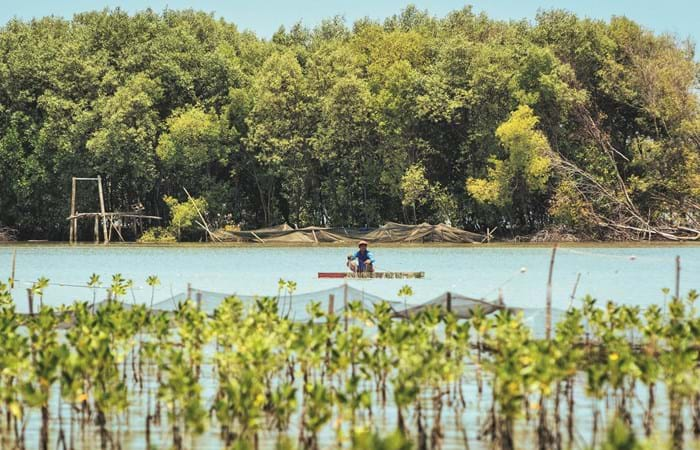Mangrove forests are unique ecosystems that thrive in the transition zone between land and sea. Frequent tidal flooding has driven evolution here: flora and fauna have adapted to cope with fluctuations in salinity, oxygen and nutrient concentrations.
Mangroves are crucial for the protection and biodiversity of tropical and subtropical coastlines. However, mangrove areas have been severely degraded over the past decades and their restoration is long overdue.
At Boskalis, we continuously explore opportunities to include mangroves in our projects and add ecological value, protect coastlines and boost local economies for all stakeholders.
BENEFITS
Coastal protection
Mangroves are the first line of defense against flooding, hurricanes and storm surges. Their extensive root structures stabilize the underlying sediment, reduce erosion, and dissipate wave energy, preventing billions
of dollars in flood damage every year. They can adapt to changing environmental conditions and provide a long-term, efficient mitigation to increasing storms.
Biodiversity
Mangroves support unique wetland communities by stabilizing the sediment and filtering pollutants from the water. They are also important nursery and feeding habitats for fish, birds, mammals and invertebrates.
Carbon storage
Mangroves are among the most effective carbon stores on the planet. The stored carbon in coastal ecosystems can remain stable for thousands of years. This ‘Blue Carbon’ highlights the unique potential of mangroves to protect the local and the global environment through carbon capture and storage.
Economy
Mangroves are not only natural fish factories, they also generate significant local revenue for local communities by providing valuable timber and non-timber resources, and by facilitating leisure activities such as eco-tourism, snorkeling and birdwatching.
OUR APPROACH
Mangroves can be restored by establishing the right environmental conditions and removing the barriers to
natural regeneration. Suitable sites can be identified on the basis of the local ecology, hydrology and
morphology, as well as the optimal growth parameters and the preferred species for the specific area.
We have a range of engineering solutions for establishing the right conditions. For example, in collaboration with local stakeholders, we can deposit additional sediment or place permeable protective structures on eroding coastlines to raise bed levels and restore the sediment balance.
OUR EXPERIENCE
Research & Development
We draw on data analysis, modelling studies and hydraulic experiments to learn more about mangrove ecosystems, including their potential to reduce flood risks. These results are then implemented directly in the design and execution of our projects.
Restoring mangroves
We work on several mangrove restoration projects across the world. On the north coast of Java, severe coastal erosion and land subsidence had led to the collapse of the ecosystem, causing the coastline
to retreat several kilometers. With a sophisticated combination of mangrove restoration, small-scale engineering and sustainable land use, the shore bed level was restored, making mangrove restoration
possible. The mangroves provide an extra source of income for the local community, whilst protecting the hinterland against further erosion, sea level rise and extreme weather. This approach could be used in
countries with comparable coastlines and coastal threats. It forms a simple solution that requires advanced knowledge and expertise, thereby providing a cost-effective alternative, compared to applying only traditional hard infrastructure which does not adapt to higher sea levels as mangroves do.
COLLABORATION
We have a strategic partnership with Wetlands International and we are a leading partner of the EcoShape consortium, executing the Building with Nature program. With our partners, we work on research, pilot
studies, tenders and projects. We share our insights, scientific knowledge, and technical expertise with our clients. Community involvement is essential for the long-term effectiveness of mangrove restoration
projects. We engage in close relationships with local stakeholders, land-owners, and communities. For example, coastal field schools can be set up to train villagers to identify and develop successful aquaculture
practices, and also care for the mangroves that are so important for coastal protection and water treatment.
WHAT CAN WE OFFER?
We can develop designs together based on beneficial reuse of material.
